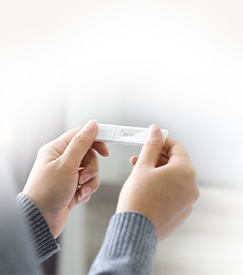 Pregnancy can be a stressful and emotional period for birthmothers, especially if they don’t know what to expect. That’s why it’s important to get to know some of the pregnancy basics as well as the pregnancy timeline.
Pregnancy can be a stressful and emotional period for birthmothers, especially if they don’t know what to expect. That’s why it’s important to get to know some of the pregnancy basics as well as the pregnancy timeline.
Pregnancy Basics
You don’t need your algebra notes to calculate your due date. The 40 weeks of pregnancy aren’t counted from the day you conceived, they’re counted from the first day of your last menstrual period. Full-term pregnancy is considered to be anywhere from 38 to 42 weeks long. Your due date is counted this way since it’s not quite possible to exactly determine when you ovulated and the exact date when you conceived since sperm can fertilize an egg three days after intercourse. Although your doctor will calculate your due date, it’s also good to know how to do it for yourself; check out our due date calculator.
It’s important to know that your due date should only be used as a guide. Most babies are born within two weeks before or after their due date.
Pregnancy Timeline
A typical pregnancy is divided into three sections, called trimesters. Each one lasts about three months.
First Trimester (1-12 weeks)
This is the most critical time in your pregnancy. The fetus is only about 4 inches long at the end of these first three months, and everything from the nervous system to major organs starts to form. This is the time to eat plenty of healthy food since you’ll need extra nutrients for your growing baby. This is why it’s so important to consult your doctor about taking prenatal vitamins. For birthmothers, this is the time accompanied with mood swings, morning sickness, nausea, and constipation. Your system is fully engaged in creating a healthy environment for your fetus, so it’s normal for you to feel tired a lot during the first trimester.
Second Trimester (13-28 weeks)
This pregnancy period is slightly better for you. Nausea should be fading and you’ll feel more energetic. Your baby is growing quickly and by now you can learn the gender of the baby. This is also the period in which you will begin to feel your baby move. All of your baby’s internal organs have formed in this period, and your baby can now begin to hear.
Third Trimester (29-40 weeks)
In this trimester, your baby will get a whole lot larger. At birth, most babies weigh between six and nine pounds and are 19 to 22 inches long. It’s important to eat a lot of calcium during this period since your baby’s bones, skin, nails, and hair are forming. Around week 29, your baby’s touch receptors will be fully developed. You’ll also experience some changes including abdominal achiness, lack of bladder control, leaky breasts, and fatigue. For a birthmother, this is also the time to prepare for the labor and delivery, so learn as much as you can just to handle this last stage as easy as you can.







